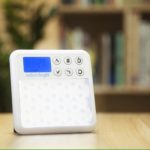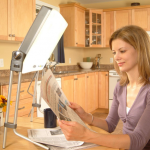Fall is here and winter is just around the corner! It’s getting to that time of the year where highly sensitive people begin to become affected by the changing of the seasons. We’re talking about the people who need the sun to thrive. The people who enter hibernation when the sun starts to set at 5 pm. We’re talking about victims of seasonal affective disorder, or seasonal depression. This is a condition that affects millions of people each year! Some people don’t even know they suffer from these “winter blues.” But no worries, there is a cure. There are actually 6 of them!
Understanding Seasonal Affective Disorder…
Seasonal affective disorder (SAD), or seasonal depression, is a mood disorder and mild form of depression. Unlike major depression, SAD is temporary. It occurs at the same time each year, usually in the fall and winter months. Some people experience SAD in the opposite months…leaving them to struggle with depression in the spring and summer and not finding happiness again until fall and winter. This form of the depression is much less common. SAD is extremely frequent, affecting more than 3 million US cases each year. It is typically treatable and not a long term condition. The disorder usually resolves within months.
What Are The Symptoms?
Symptoms for winter and fall seasonal affective disorder may include…
• Irritability
• Tiredness or low energy
• Problems getting along with other people
• Hypersensitivity to rejection
• Heavy, “leaden” feeling in the arms or legs
• Oversleeping
• Appetite changes, especially a craving for foods high in carbs
• Weight gain
Symptoms for spring and summer seasonal affective disorder may include…
• Depression
• Trouble sleeping (Insomnia)
• Weight loss
• Poor appetite
• Agitation or anxiety
(Symptoms lists from MayoClinic.org)
Why Seasonal Affective Disorder Is So Common…
We do not know exactly why SAD occurs and what causes it. However, many studies have been done in attempt to figure it out. Our biological clock (Circadian Rhythm), is the main factor. Due to the increased amount of darkness and decreased amount of sunlight in the fall and winter months, our body’s internal clock is off. This can lead to feelings of depression. Another major factor is our serotonin levels. Serotonin is a neurotransmitter chemical in our brains that affects our moods. When the amount of sunlight that we are exposed to is reduced, our serotonin levels drop, prompting depression. The third reason is our melatonin levels. Melatonin is a hormone in our brains that anticipates the daily onset of darkness. When our light levels are off, for example, when it gets dark at 4 p.m. due to daylight savings, our brain gets confused and releases melatonin. This tricks our brain and body and messes up our brain waves as well as our energy levels.
The Huffington Post took to their Healthy Living blog to discuss “10 Things Everyone Should Know About Seasonal Depression.” Lindsay Holmes, Healthy Living Editor, went in detail explaining how Seasonal Depression should be analyzed and discussed with a doctor. Holmes claims that sometimes Seasonal Depression is a sign of underlying depression. She also says the condition is not something to joke about and it’s an actual serious illness. For her eighth and ninth reasons on the blog, she explains where the depression seems to be the most prevalent as well as who seems to deal with it the most. Holmes says:
“It’s more prevalent in northern states. People who live in colder, cloudier climates may be more susceptible to the disorder. Northern states have higher rates of SAD than southern states, according to the University of California, Irvine.
SAD is more common in women. Studies show women have higher rates of depression than men, including SAD, the New York Times reported. However, that doesn’t mean men are immune. Depression doesn’t discriminate and can affect anyone, regardless of gender, ethnicity or any biological factor.”
(HuffingtonPost.com)
Light Therapy and Seasonal Affective Disorder…
Light therapy is a form of therapy that uses different forms of light to treat a wide array of conditions. Doctors of all sciences have been using light therapy on their patients for years. Thanks to the convenience of new light therapy products, it is now easy and accessible to use light therapy products at home. Light therapy has been helping to cure SAD on ground-breaking levels and there is no sign of it stopping.
Most people suffering from SAD don’t do anything to fix the issue. Instead of looking for an answer, they assume it’s normal. They sleep in a little longer, drink more coffee, and wait for spring to poke it’s head out. Some people don’t even know they are struggling with something that is actually medically recognizable. To them, it’s just the winter blues. But by ignoring the fact that they’re suffering, they’re missing out on some months that could be wonderful. With today’s modern technology, there’s no need to avoid the topic anymore. There are six forms of light therapy that have been proven effective at treating seasonal affective disorder.
Top 6 Forms of Light Therapy for SAD…
1. Dawn Simulators
Dawn simulators mimic the natural rising of the sun and are the most natural, authentic form of light therapy. There are two different types of dawn simulators. One option simulates the natural representation of dawn for a springtime sunrise. Another option simulates a sigmoidal shaped dawn that can last between 30 minutes to 2 hours. Dawn simulators are highly effective because early morning light signals are much more powerful in regards to our brains that any other light sources throughout the day. Our brains are sensitive to morning light.
Dawn simulators can be a stand alone light source that is a bit like an alarm clock or it can be an attachment that you plug into your bedside lamp.
2. Light Boxes
Light boxes are the most common form of light therapy. They are used in clinical studies and always promote positive results. They are flat screens that emit a full spectrum fluorescent light. The light box typically emits 10,000 lux.
These devices are used on a set schedule. Patients sit in front of them each day at the same time for between 30 to 60 minutes. These devices are easy and you can use them at your own convenience. For example, when you’re reading the newspaper or eating your breakfast each morning.
3. Natural Spectrum Light Bulbs
Natural spectrum light bulbs are simply an addition to a lamp at your home or work. They can be used on a set schedule just like a light box or they can be left on throughout the day, just like a normal lamp. They typically emit at least 10,000 lux and are known to be highly effective. Just like light boxes, these bulbs can adjust your circadian rhythm and boost your mood levels.
4. Bluewave Technology
Blue light, or blue wave technology, is another form of light therapy used to treat seasonal affective disorder. It is used in the form of a light box, just like the option discussed above, but the light panel or bulbs are slightly different.
The only downside to this option is the blue light is extremely similar to the light that is emitted by technology such as your cellphone or computer. Studies have shown that using a cellphone, computer, tv, etc., before bed can effect your sleep in a negative way. So if you are planning on using blue light therapy, be sure to do your treatment session earlier in the day to avoid any potential sleep issues.
5. Bright Light Sun Visors
A light therapy hat! So fun, right? These personal light therapy boxes are worn as a hat. They are used for a set amount of time each day and can let you keep your light therapy box right on your head for easy convenience throughout the day. This is wonderful if you’re a busy bee!
Be sure to use bright light sun visors with caution and read all of the instructions on the packing first. Keeping a light source so close to your eyes is definitely something that needs to be monitored.
6. Light on a Timer
This form of light therapy for seasonal affective disorder is similar to a dawn simulator except it can be used at any time throughout the day. Also, the change in light is far more abrupt than a simulator. This form of therapy is helpful for people who struggle with getting out of bed in the morning or who often forget to do their light therapy treatment sessions.
Try setting the lights in your room on a timer. With the help of your alarm clock you will definitely wake up in time and have a great, serotonin filled day. Or perhaps the warm light in your office will automatically turn on for one hour each day, mimicking the outdoor light and keeping your circadian rhythm in check.













